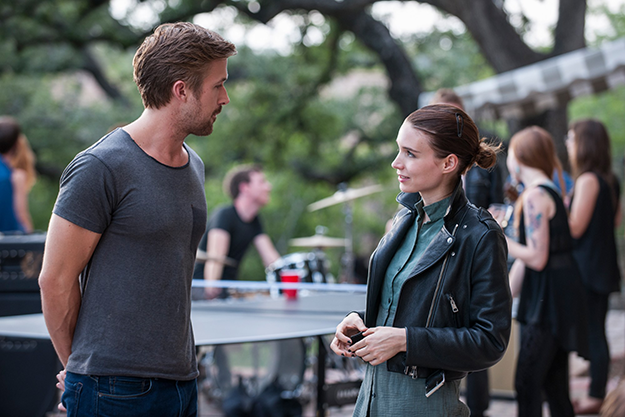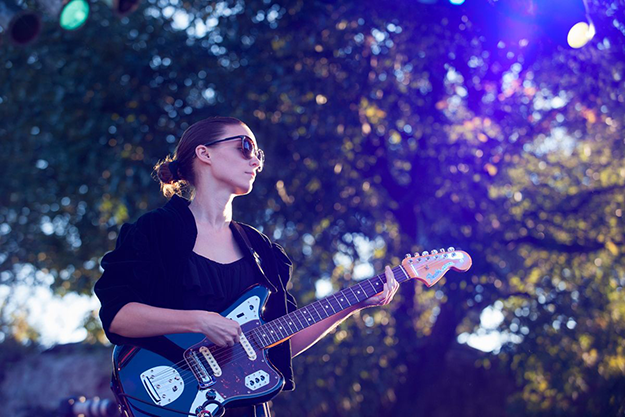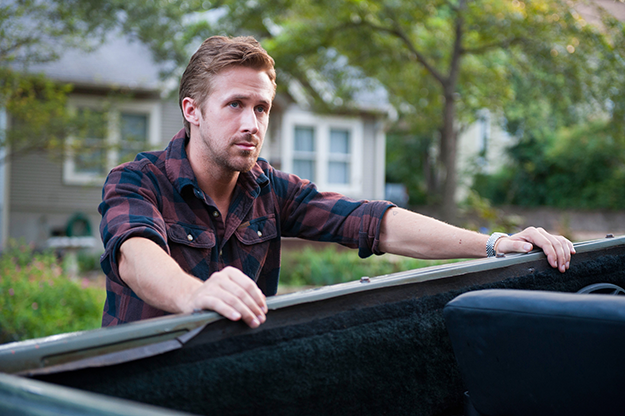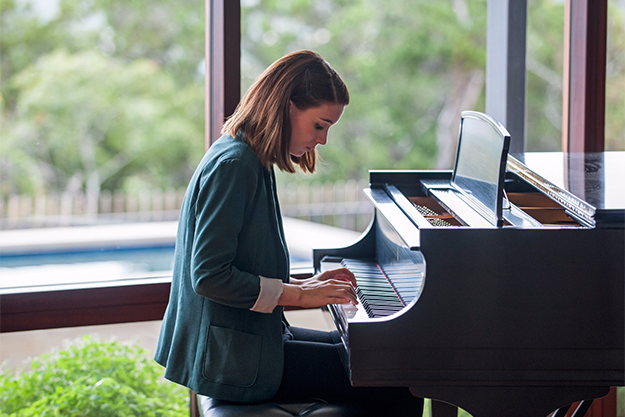Throughout Song to Song, the latest film by Terrence Malick, movie people play music people trying to act authentic and impulsive. Motivated by Malick’s late career interest in capturing life on the fly—one glimpsed, gestured, magical moment at a time—Michael Fassbender gallops after seagulls as if he were a hunchbacked ape, Ryan Gosling leans so far back on a chair that he falls backwards, later tromping through a puddle on a scenic mountaintop to apprehend Rooney Mara, who eludes him, flashing back with a coy grin. They’re chasing after the spontaneous moment as if it were oxygen, as if it were reason and meaning. “I was desperate to feel something real,” Mara says during an opening voiceover, and though she’ll often cede VO to Gosling, Fassbender, and Natalie Portman, her confessional, past-tense musings lead the film. “Any experience was better than no experience,” she says, speaking specifically about an impulse toward rough sex, but it stands for much of what’s pursued by the film’s characters throughout the film. And so Faye, Mara’s young, tentatively aspiring Austin musician, gets involved with her employer, a hotshot producer played by Fassbender, finds both joy and heartbreak with Gosling’s driftwood troubadour, and embarks on an affair with Bérénice Marlohe. She lures and is lured, escapes and pines for her family, takes a private jet to Mexico with both men, seeks the counsel of Patti Smith. She “shows houses” for a living, which brings her to mansions, old suburban homes, and glass-walled apartments high above Austin, all serving as stage sets for her romantic encounters. As do locations visited throughout the city, from rooftop bars and outdoor music venues to scenic lookouts and parking lots. Trying to feel (and as actors, represent) something real, they flirt and dance and gesticulate and strain across the landscape. And the landscape looks on. Contrary to how it may seem—certainly to how it may appear in promotional stills or in short clips—there’s no negative space in Song to Song. Mara stands by a window, looking out. The camera glides from her at the center of the frame to situating her toward the left of it, making more room for the window and the trees beyond it. In another movie, that widened space would serve to concentrate our focus on her, as the rest of composition serves to suggest her state of mind, or suggest how we might feel about her. But Malick’s camera, as operated by DP Emmanuel Lubezki and steadicam wiz Jörg Widmer, isn’t trying to artfully or moodily frame a subject, not even one as strikingly beautiful as Rooney Mara; it’s rather asserting that everything visible is the subject. Her face. The window. The trees. Everything the camera corrals is equally subject to its, and our, attention.
The camera moves and moves, and yet it doesn’t assert depth, it flattens. Like a thickly painted canvas, Malick’s compositions bring background into the foreground, and the camera insistently pans away from movie stars to dwell upon running water, or ducks, or tourists on Segways. All is the same. All is fodder. All is holy and disposable. This doesn’t mean that certain characters or objects aren’t of special interest in the film—there’s actually more plot and detectable character development in Song to Song than in previous features Knight of Cups and To the Wonder—but it does mean that individual shots are unlikely to make that case. The shots are too busy changing shape and meaning as they go. Since film is a time- and motion-based medium, it stands to reason that its compositions are inherently unstable, perpetually developing. Yet how often do you see this embraced at all times during a narrative film? We tend to speak of film composition when a frame is firmly or relatively locked, which is when film most resembles painting. Malick himself pursued such compositions in his two first films, Badlands and Days of Heaven, studies in light and landscape that evoked American artists like Andrew Wyeth and the Hudson River School painters. But from The Thin Red Line forward, culminating in Song to Song, his frames have become increasingly activated, defined in the five most recent films by Lubezki’s swinging, unstable approach to space, gesturing impulsively and responsively yet always authoritatively. The camera’s discursive attentions are less free-associative than inclusive, leveling. People, landscape, objects, animals, houses, fields—they all share the same cinematic plain. And all are simultaneously interrelated and allergic to one another, in harmony and contrapuntal, a unified frame as well as a revolting one. Pan from Gosling effortfully animating to a plant defiantly sprouting from a great rock. Does one comment on the other? Perhaps yes, but also no. We hear harmonies in the world, but Malick’s films have a way of calling these out while also contradicting them, in letting the wildness of the world overwhelm our desire for order. So egalitarian is Malick’s gaze that you could see the actors as playthings of the world as easily as you could see the world as a playground for the actors. Even in an environment as choked as Fassbender’s character’s estate, with its immaculate lawns and sequestered shrubbery, Malick doesn’t represent nature as subjugated or secondary, but persistent, conspicuous.
Such single-plain shot composition is served by a steadiness of imagery constructed in the edit. We never linger in a moment, or in a shot, or in a location. Any given detail is temporally deemphasized—though some inevitably linger in the memory. Shots progress as you might scan a Bruegel or Bosch canvas. (A short glimpse of such a painting flicks by at one point, though I wasn’t clear if it was an actual Dutch painting or a copycat work decorating Fassbender’s nouveau riche mansion.) Unlike a painting, Malick’s film is fractured by cuts, yet through crowded, non-realist, non-temporal composition those paintings exhibit a similar disjuncture, and both film and painting coalesce into a whole—a whole compressed with life. Mara. Gosling. Chickens. Donkey. Fassbender. Piano. Synthesizer. Guitar. House. Apartment. Development. Tree. River. Mountain. Gas station. Highway. Telephone wires. Birds. A fence. A dragonfly. A moth. Fassbender wrestling Flea. Val Kilmer knifing off his hair. Bubbles rising beneath the surface of a pond. There’s evenness to the deployment, whilst ideas progress—far more intricately and mysteriously than it might seem. Malick’s associative progressions elude easy interpretation, playing more like a jazz soloist’s embellishments than an ascending scale. And motifs do arise, most evidently trees, windows, caressed bellies, and in Will Patterson’s virtuosic sound design, invasions of crickets and birds and wind overtaking dialogue. Actors emote in front of nature, while nature keeps spilling into private interior spaces. The camera swings and tilts and travels, yet keeps preferring a plane beneath the eyeline that incorporates the sky, or the oscillating ceiling fan, and emphasizes the vulnerability of the neck, and of whitened eyes uncertain of where to look or what to think. The film is always in motion, and yet there’s an implied stillness in those eyes, a terror that once everything stops moving we’ll be left alone with the smallness and futility of it all. Through blanketed voiceovers we’re brought into a first-person interior space—depending on the voice, these can be confessional, prayerful, ponderous, and via Faye’s backwards-looking musings, authorial. Through cinematography we’re given a more objective vantage—though thanks to proximity, and Lubezki’s fisheye lenses, we have a sense of the subjective as well. And through editing we’re nearly omniscient. But only nearly. Even the godlike maker of the work we’re watching runs up against limitations; he can’t corral everything that’s out there. It’s how the film’s pursuit matches that of its characters, how the director’s formal tactics rhyme with that of his actors, how the audience’s frustrations are foretold in the material. Everything is defined by limits, and when those limits are enforced they have a way of belittling any effort at transcending them. They keep reaching, and yet things still elude their grasp. The picture tries to show everything, and yet there’s still a frame, still a demarcated beginning and ending, a border between this and that, a line between you and me. Behold distance and futility. And in their attempts to defy limitations, behold grace.
“I thought we could just roll and tumble,” Mara says, and like much of her ruminations, it’s a better approximation of pop’s heedless desperation than any specific invocation in the film’s drift through Austin’s music scene. You get glimpses of Iggy Pop and John Lydon, spend an afternoon with Lykke Li, and they’re more as incantations than characters, more textures and backstories to contemplate on the canvas. But nothing feels more appropriate to the endeavor than a blast of Del Shannon’s “Runaway,” which both encapsulates everything transpiring in the film and supports the endless irreducibility of these conflicts and desires. A 73-year-old filmmaker explores the conflicts and milieu of characters several generations younger, reaching back as they reach forward, and meeting in the infinite middle. “As I still walk on I think of the things we’ve done together, while our hearts were young,” Shannon sings, which Gosling later reprises as a low wattage dirge. There’s regret, there’s pining, and there’s also an undercurrent of marvel. And there’s the song’s three most common words, called out and ornamented: run, wonder, and why. Eric Hynes is a journalist and critic, and associate film curator at Museum of the Moving Image in New York.



